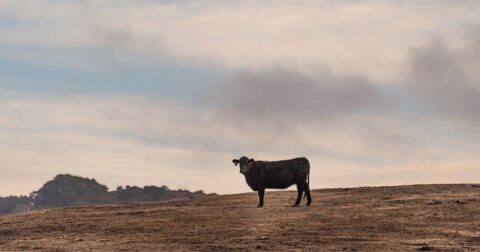Investigation
California’s Factory Farms Are Perilously Close to Your Produce, New Report Finds
Food•4 min read
Analysis
Bolivia's growing factory farm industry is putting the Chiquitano Forest at risk.


Words by Matilde Nuñez del Prado Alanes
The Amazon fires of 2019 captured the public’s attention — causing massive damage to one of the world’s most important carbon reserves and sparking widespread condemnation of Brazil’s President, Jair Bolsanaro. Yet most of the world has ignored the almost 3 million hectares of Chiquitano dry forest consumed by fire that very same year, and the vast tracts of unique ecosystem that have burned to the ground every year since.
The Chiquitano forest covers around 24 million hectares — nearly the size of the U.K. — most of which is located in eastern Bolivia, covering more than half the territory of the country’s biggest state of Santa Cruz. The Chiquitano is home to a wide diversity of plants, animals and geological formations, as well as Indigenous peoples with a huge cultural legacy.
Though it’s one of the largest tropical dry forests in South America and the world’s best preserved, the Chiquitano is rapidly being deforested for intensive farming operations — mostly soy and cattle. Yet because it’s not as well-known or studied as the Amazon, most of the public is unaware of the looming danger.
When soy farms and cattle ranches clear land for expansion, they often use what is supposed to be a controlled burn. Yet the resulting fires often grow out of control, and the damage is essentially irreparable — emitting large amounts of carbon into the atmosphere, but also threatening the survival of thousands of animal species and their food sources, breeding sites and shelter. The smoke also hurts animals and humans, causing eye and lung damage as freshwater sources in the forest become contaminated by leaching ash.
Fires in Bolivia are almost always set by humans to clear land — primarily for farmland expansion, including animal farming and soy for livestock feed.
According to Fundación Tierra, around 70 percent of soy farmland in the region is controlled by only two percent of soy producers. Most of the production is used to feed farmed animals, both in the country and abroad. Between 2005 and 2019, on average, almost 80 percent of the total soybean production was exported.
While climate change plays a role in the intensity of fires as increasingly long and harsh dry seasons and higher temperatures create the ideal conditions for spread, various monitoring institutions, including Global Forest Watch and WWF, report that these fires are due mostly to the exponential growth of industrial agriculture in the region — mostly soybeans — and livestock.
Over a 20 year period, Bolivia has lost forests on a massive scale — placing it among the top 10 countries for global tree cover loss between 2001 and 2021. The World Research Institute ranked Bolivia third for forest loss in tropical countries in 2021. Most of this loss is located in Santa Cruz, “the epicenter of large-scale agriculture like soy and cattle ranching.”
According to the report Deforestación 2016-2021, from Fundación Tierra, deforestation between 2016 and 2021 exceeded 300,000 hectares per year on average — representing an annual emission of 30 to 40 million tons of CO2 or three times more than the combined emissions from transportation, industry and electricity generation in the country.
In 2019, Bolivia suffered the most devastating fire on a global level and one of the worst environmental disasters in its history. According to the World Wildlife Fund (WWF), 6.4 million hectares were affected by fire and, as a result, the country emitted 159 megatons of CO2 that year.
Over two-thirds of the burned areas were in the Chiquitano forest, where it is estimated that about six million land mammals and almost all amphibians and reptiles in fire areas died. Among the animals most affected by the fire are urines, capybaras, ocelots, anteaters, badgers, pumas, tapirs, jaguars, turtles, lizards and pacas, without taking insects into account. Endemic species, such as the chichilo monkey, the colorful harpy eagle, and the chiquitana frog, were also put at high risk.
Yet since then, the region has experienced more fires that have been almost just as devastating — 4.5 million and 4.2 million hectares burned in 2020 and 2021, respectively. In each case, the Chiquitano forest was the most affected area.
What the loss of these precious forests means is massive loss of life, yet the public is barely paying attention. Tropical dry forests are considered one of the most important in the world for conservation, and the Chiquitano is no exception. More than 1600 species of animals have been recorded there, according to Roberto Vides-Almonacid, CEO of the Foundation for the Conservation of the Chiquitano Forest. It’s also critical for keeping carbon out of the atmosphere — the 54,000 hectares making up the protected area of Tucabaca mitigates 1.6 million tons of carbon emissions each year.
Over 97 percent of the current plant cover in these forests is now in danger of extinction, according to an International Union for Conservation of Nature report, and that loss has rippling effects — 66 percent of the freshwater reservoirs in the Americas and more than 100 million people are dependent on these ecosystems. In South America, where more than half of tropical dry forests are found, some of these forests are now less than 10 percent of their original footprint, while for others deforestation is increasing at alarming rates.
Despite the harm to the planet, humans and animals that live in the region, the country’s political leadership is pushing for more growth in the industrial agriculture sector. Bolivian President Luis Arce’s four year plan proposes to exceed 18 million head of cattle and export 30,000 tons of processed meat per year — 15 times more than the annual exports between 2013 and 2018.
Yet in the first seven months of 2022, 18,000 tons of meat worth $110 million were exported — with about 80 percent going to China, 15 percent to McDonald’s in Peru and Burger King in Ecuador and the rest is distributed among other countries, including Venezuela, Vietnam and the Republic of the Congo. Cattle ranching’s vast expansion is thanks to the “Patriotic Agenda 2025.” Adopted in 2013, the policy established a target of transforming animal farming to semi-intensive and intensive systems to triple the population of large livestock to two cows for every human resident.
To stop the environmental damage, Bolivia must abandon some targets of the Patriotic Agenda and repeal the so-called “incendiary package” — a set of laws that legalize deforestation, authorize clearing with fire and forgive debts for illegal burning. The country ought to withdraw from its meat export pact with China, and establish institutional mechanisms to apply the Law of Rights of Mother Earth — approved 12 years ago but left aside ever since.